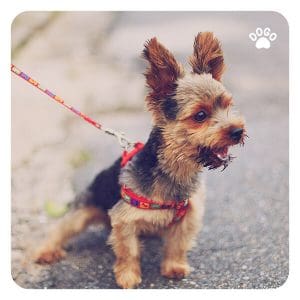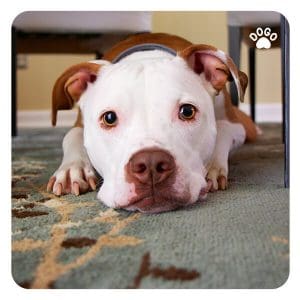If you struggle with your dog’s aggressive behaviors, this article is for you. How do you eliminate the aggressive behaviors that your dog exhibits? First, you need to recognize their cause. Read our article to understand aggression in your dog. We will give you tips on how to deal with it.
To begin with, ask yourself a few questions:
- How does aggression manifest itself? How does your dog exhibit it?
- Has the aggression always been there, or is it recent?
- If it is recent, could something have happened to provoke it?
- How often does it occur?
- In what situations does it occur?
- Towards whom/what is it displayed?
- How do you deal with it as an owner?
- Do you see any effects of your actions?
If you recognize the cause, you can move on to taking action:
If the reason for your pet’s aggression is poorly executed socialization, start re-socialization.
 It is a more difficult task than classic socialization because you have to correct the mistakes that were made in the early stages of the dog’s life. Focus on changing the dog’s attitude to the environment, especially to those stimuli that stress them and provoke aggression. A suitable method is to build a positive association with the triggers.
It is a more difficult task than classic socialization because you have to correct the mistakes that were made in the early stages of the dog’s life. Focus on changing the dog’s attitude to the environment, especially to those stimuli that stress them and provoke aggression. A suitable method is to build a positive association with the triggers.
Try to familiarize your dog with the situations, things, animals, people that provoke aggressive behavior. Manage the distance, first find yourself at a safe distance. It is the distance where the dog does not yet show aggressive behavior. Then keep them busy with something positive, such as a chew, a sniffing activity, playing together, or obedience training. Over time, gradually decrease this distance and repeat the pattern.
If the dog uses aggressive behavior, reduce the difficulty level and stand further away. Show your pet that they don’t have to attack in uncomfortable situations – they can use the space they have and simply walk away. Don’t force your dog to do this by pulling on the leash. Encourage your pet to walk away using their favorite treats or playtime. The result should be that you are close to the trigger but without an aggressive outburst.
It’s important to note that re-socialization should always be done under the guidance of a professional trainer or behaviorist. The process can be slow and requires patience and consistency. It’s important to start with small steps and gradually build up to more challenging situations. It’s also important to recognize that not all dogs may be able to be fully re-socialized, and it’s important to manage their behavior in a way that keeps both them and those around them safe.
For aggression caused by your dog’s hunting instinct, focus on meeting your dog’s instinctive needs daily.
Behaviors resulting from the hunting instinct are deeply rooted in the dog’s nature. They are tough to eliminate. However, you can reduce the risk of them appearing at the least appropriate and expected moments. If you activate your dog’s instincts on a daily basis, they will not try to do it on their own and unexpectedly. You can begin to control it by allowing the dog to release them at other times – planned and managed.
How to do it:
- When your dog tends to chase other animals, you can enroll in a “Sheep Herding” class with them or start practicing a dog sport.
- When your dog tends to bite and tug on other animals or people, you can play tug of war with them every day and provide natural chews.
- When your dog tends to track and spot prey, you can provide more sniffing games or enroll them in “NoseWork” classes.
It’s important to remember that while meeting your dog’s instinctive needs can help reduce their aggressive behavior, it’s not a guaranteed solution. It’s important to monitor your dog’s behavior and seek professional help if the aggression persists. Additionally, it’s important to ensure that any hunting or prey drive activities are done in a safe and controlled environment to prevent harm to other animals or people. Finally, it’s important to recognize that some breeds may have a stronger hunting instinct than others and may require more intensive training and management to reduce their aggressive behavior.
Keep your dog calm – reduce their over-excitement.
 If you reduce your dog’s level of excitement on a daily basis, you will reduce the risk of aggressive outbursts. Emotions will not accumulate and explode in random situations. A calm and balanced dog is much less likely to attack.
If you reduce your dog’s level of excitement on a daily basis, you will reduce the risk of aggressive outbursts. Emotions will not accumulate and explode in random situations. A calm and balanced dog is much less likely to attack.
Try to provide your pet with an appropriate dose each day of::
- chewing;
- sniffing;
- exercise;
- mental work;
- play;
- rest.
Chewing and sniffing are natural forms of relaxation for your dog. Movement helps reduce the excess energy. Playing makes it easier to relax, to let go of tension. On the other hand, proper rest is responsible for regeneration and total reduction of stress levels in the body. Mental work calms down, teaches to be humble and to analyze situations as they occur. All of it affects the overall behavior of your pet and their self-esteem.
Adjust each of these aspects according to your dog’s breed, age, health, and personality. Observe their daily behavior, and based on that, determine their needs and adjust the stimulation.
If your dog’s aggression is a display of strength and independence that manifests itself through resource protection – check out DOGO!
In our “Good Manners” section, you will find the “Resource guarding” program. You will learn how to stop your dog from protecting and defending their food. You can use this method on any object that your dog decides to defend.
If aggression occurs when you touch your dog, consider the following:
- You need to observe whether the dog reacts badly to the touch of a particular body part or general petting, hugging, kissing. For example, if they suddenly won’t let you touch their paw, consult your vet. It’s worth it to check if everything is okay. It happens that dogs behave aggressively when somebody tries to touch the sore area. They may also get angry if someone tries to approach them at that time.
- Constantly monitor your dog’s health. Doing so will reduce the risk of unpleasant medical conditions and the aggression that can come with it.
- What if your dog constantly shows their teeth, grows, and barks when you try to touch them? This behavior is common in dogs that humans have physically mistreated. Typically, these situations occur in dogs who have had unpleasant life experiences. These dogs might be driven by anxiety and fear, so they use aggression for self-defense.
- Another reason for aggression may be a lack of exposure to human touch. It is common for not domesticated dogs or those that have not had much interaction with humans. In either case, you can benefit from DOGO. In the “New Dog” program, we have included a “Touch” exercise to help you learn how to get your pet used to be petted, picked up, and cuddled. You will also find exercises such as: “Put on a collar” or “Put on a leash,” which will prevent aggression when getting your dog ready for a walk.
Basic Rule
 Keep in mind that aggression creates aggression! Remember never to shout at your dog or use physical violence when they behave aggressively. If you do, you may provoke your dog into an even more intense attack. Try to calmly analyze the situation and understand the reason for your dog’s behavior. A vet, behaviorist, or trainer will certainly be able to help you choose the correct methods to deal with it.
Keep in mind that aggression creates aggression! Remember never to shout at your dog or use physical violence when they behave aggressively. If you do, you may provoke your dog into an even more intense attack. Try to calmly analyze the situation and understand the reason for your dog’s behavior. A vet, behaviorist, or trainer will certainly be able to help you choose the correct methods to deal with it.
[/fusion_text]



